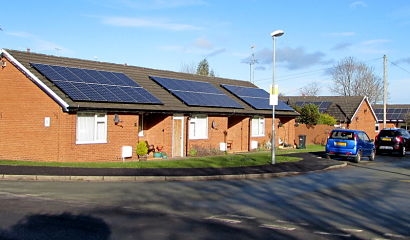
Perovskite solar cells have attracted interest because, unlike silicon solar cells, they can be mass produced through roll-to-roll processing. Additionally, they are light and colourful, with the versatility to be used in non-traditional settings such as windows and contoured roofs. However, up until now, application has been impacted by potential environmental risks. Perovskite solar cells contain lead, a cumulative toxin, and if the cells get damaged, lead ions may leak.
Taking lessons from nature, Professor Brian Saunders and Dr David Lewis have devised a way to eliminate the lead release from broken cells. Using a bioinspired mineral called hydroxyapatite, a major constituent of human bone, they have created a ‘failsafe’ which captures the lead ions in an inorganic matrix. As a result, if cells are damaged, toxins are stored in an inert mineral, rather than released into the environment.
In a dual success, The Engineering and Physical Sciences Research Council (EPSRC)-funded project found that through the addition of hydroxyapatite, the efficiency of perovskite solar cell increased to around 21 percent. This compares to around 18 percent efficiency for control cells with no added hydroxyapatite. An increased efficiency in panels means more energy can be generated and at a lower cost.
The research team hope that the cells will bring forward the large-scale application of perovskite solar cell technology.
“Up until now, the substantial lead component in perovskite solar cells has been a potential environmental concern” said Professor Brian Saunders, Professor of Polymer and Colloid Chemistry at the School of Materials, The University of Manchester. “If the solar cells are damaged, for example by hail, the ions may leak. By creating an in-device fail-safe system, we have devised a way to contain toxic ions in damaged perovskite cells. Through increasing the inherent safety of perovskite solar cells, we hope our research will provide a helping hand to the wider deployment of solar technology as we strive to achieve net zero CO2 emissions.”
Dr David Lewis, Deputy Head of Department and Reader in Materials Chemistry, added that the scientists were committed to eliminating an environmental risk and that this commitment has now resulted in increasing both the sustainability and the efficiency of perovskite solar cells. The team hopes that these dual outcomes will increase the viability for homes and businesses, worldwide, to host and use solar technology.
The research was reported in: ‘Bioinspired scaffolds that sequester lead ions in physically damaged high efficiency perovskite solar cells’ in Chemical Communications.
Energy is one of The University of Manchester’s research beacons - examples of pioneering discoveries, interdisciplinary collaboration and cross-sector partnerships that are tackling some of the biggest challenges facing the planet.
For additional information:

